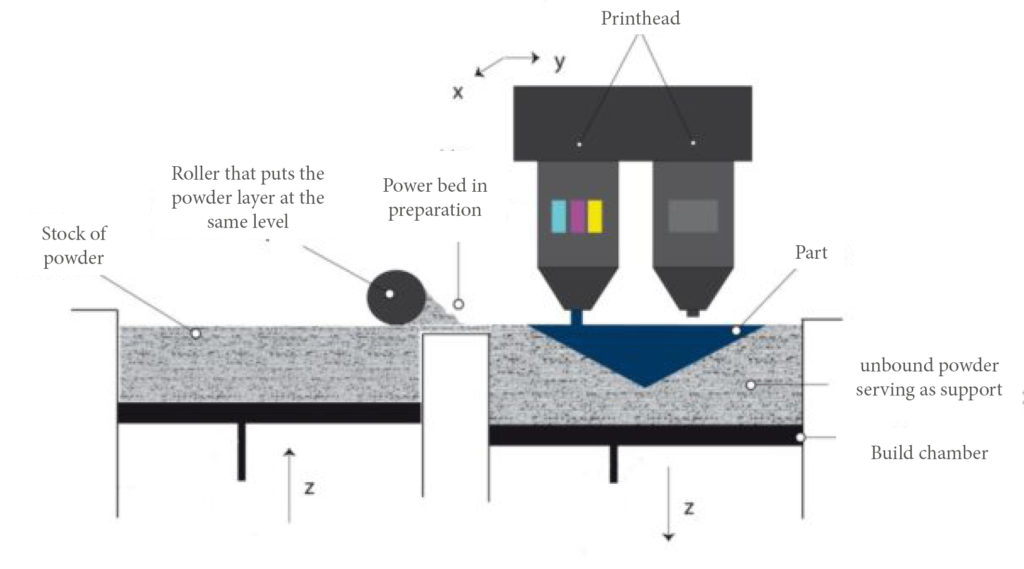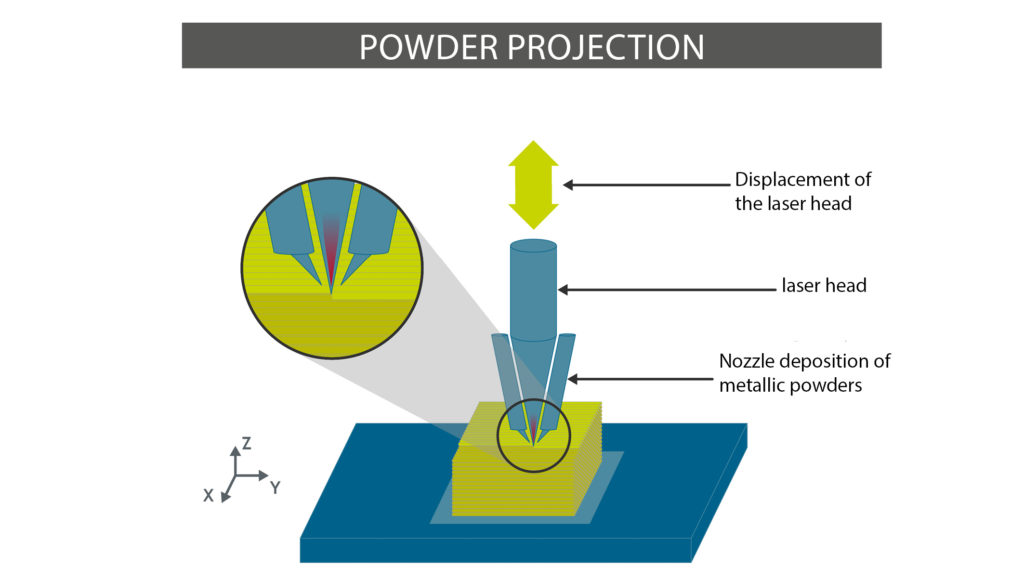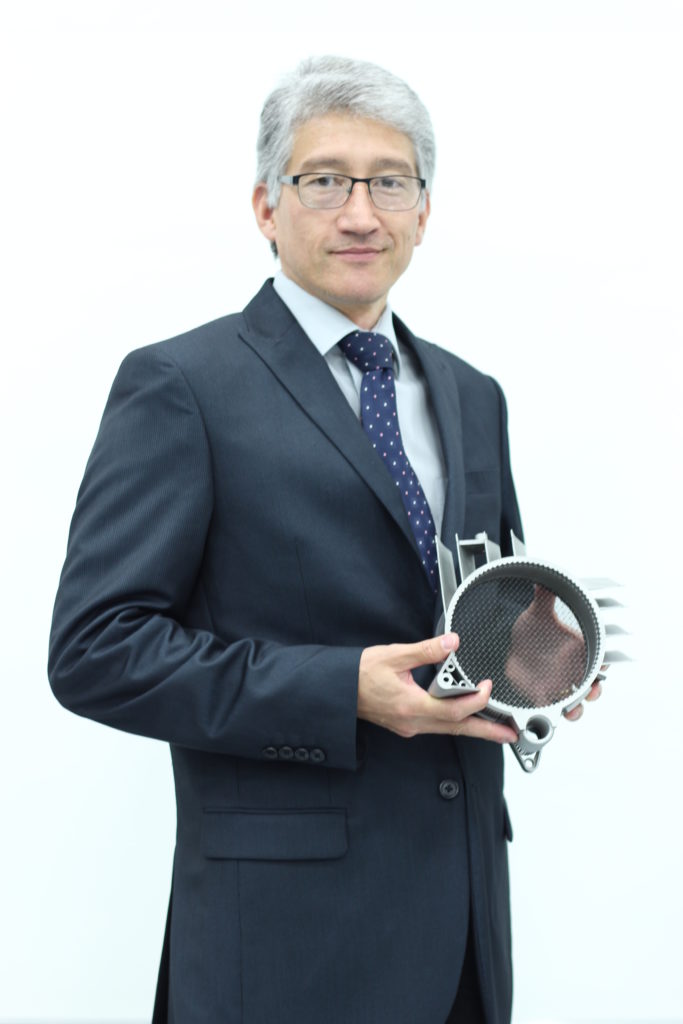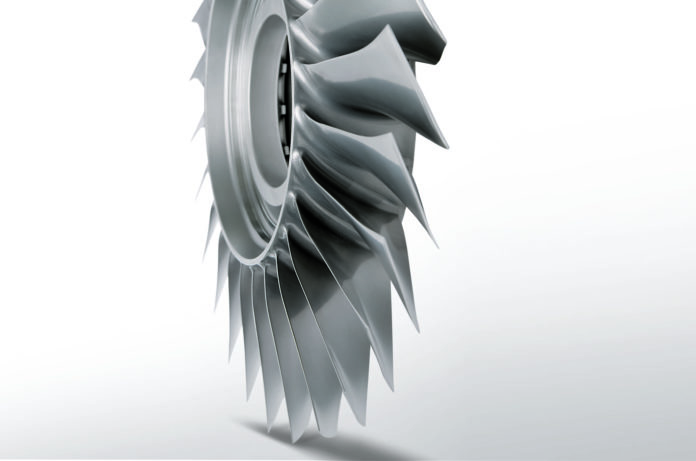In addition to the medical sector, market reports, corporate reports and even media reports reveal that the aerospace and automotive sectors are currently the most demanding sectors in the additive manufacturing market.
Surprisingly (or not), of all the technologies used in these industries, the Wohlers Report 2018, announced a “dramatic rise in metal additive manufacturing and overall industry growth of 21%».
The growth of such technology, its impact in these two sectors still raise some questions regarding its potential, its use and its limits within the industry. That’s the issue we decided to tackle this month with the participation of Benjamin Denayer (Sirris), Dr. Martin McMahon (Renishaw), Kay-O Kissling (3D Systems for Aerospace), Michael Sattler (3D Systems for Automotive), Delphine Carponcin (Airbus) and Frank Götzke (Bugatti).
1.Metal additive manufacturing (AM) in a few words …
Metallic additive manufacturing is based on the use of two main technologies: Powder Bed Fusion process and Directed Energy Deposition (DED). Simply put, in the first case, an electron beam or simply a laser will melt or sinter a narrow layer of powder. The second layer will then be deposited and melted or sintered onto the former layer.

In the case of Directed Energy Deposition (DED) on the other hand, the laser used will melt metal powder brought into the laser spot and this melted material will be projected on the object surface. Once melted, the powdery material forms a layer that will fuse with the substrate.

What type of metal additive manufacturing technology is most widely used in the automotive and aeronautics sectors?
For Benjamin Denayer, Senior Business Developer Additive Manufacturing at Sirris, LBM (laser-based manufacturing technology) is the most widely used type in both industries.
Known by various names (in this case, powder bed fusion process), Benjamin Denayer explains that, in addition to LBM, “other technologies, such as WAAM (Wire Arc Additive Manufacturing) are drawing much attention in the aeronautics sector. This technology can, indeed, construct bigger structures; is faster but less accurate. Today, building surfaces are essentially constructed with measurements of 350x350x350mm and not all applications can be printed on such printers. 3D printers’ manufacturers are investing in research and building bigger printers and maybe someday, it will also become cost efficient for bigger parts.”

What are the recommended materials for each type of technology?
Both types of metal additive manufacturing require the use of materials that are relatively diverse.
Powder Bed Fusion process or sintering technology
In general, metal, plastic or ceramic powders are used with this type of technology.
In terms of specificities, the powder bed fusion process «allows to build layers that are strongly linked to each other.” The reality is that each time a layer of material is fused or sintered, the layers that are lower and closer must recast to show a strong cohesion.
AM based on Directed Energy Deposition
The properties of a part obtained by laser melting will not be far from the characteristics of this part obtained by forging or casting. The importance of materials therefore also has a crucial role. These materials are iron, cobalt, nickel, aluminum, «all metallic materials that can be fragmented into spherical form.»
Note that despite this variety of materials available on the market, each company has its own preferences. Airbus, for instance, mainly uses Titanium and Aluminum for the manufacture of its parts while 3D Systems, in its offering to companies in the automotive and aerospace sectors, offers the possibility to manufacture parts in Titanium, Stainless Steel, Cobalt-Chrome, Aluminum Alloy, Maraging Steel, Nickel and Super Alloy materials.
However, Benjamin Denayer believes that in the current state of the market, the full range of materials that can be used in both business sectors is not fully exploited. “There are still a lot of possibilities on materials. Today, some materials are not yet printable and could be an issue. But again, when you are looking at the aerospace sector, a lot of titanium and aluminum is already used. For aerospace and automotive, there is already a large number of materials available that could work. Maybe if we look into other sectors the limits of materials are more critical but for these two sectors, not really.”
Professionals’ tendency to compare additive manufacturing (AM) materials and materials used in material removal manufacturing methods
Most of the time, in order to better understand the use of additive manufacturing technology in a given sector, engineers tend to compare it with conven-tional manufacturing methods they know best. Dr. Martin McMahon, Business Development Manager, Additive Manufacturing Solution Centers at Renishaw, draws attention today to this type of comparison with materials:
“Most people say: “how can AM materials be compared to materials used in traditional technologies?” You can make comparisons but you can never make them the same. Engineers are used to designing whilst taking into account the properties of materials for conven-tional techniques. For many years, engineers have been somewhat suspicious about metals produced by laser powder bed fusion, partly because of the misun-derstood use of the words “laser sintering”, which is now falling out of use in favor of powder bed fusion.
Most materials produced by laser powder bed fusion now exhibit mechanical properties close to standard wrought materials and attention is turning to the ability of the AM systems to consistently produce parts at an acceptable quality, backed up by sensor-based process data. Just like casting, which was only adopted in high technology manufacturing once a degree of confidence in the consistency of the process was achieved, AM will follow a similar if accelerated route, backed up by intelligent process monitoring tools and, the great number of research projects that have been carried out to understand these properties to enable people to confidently use AM components. There are still limits but a growing confidence in the data is fostering the adoption of AM materials by big companies today in production.”
Before discovering the specificities of each sector of activity, let us determine the similarities and differences that link both automotive and aerospace sectors.

2.Automotive and aeronautics: two closely related and yet very different sectors
For Kay-O Kissling, Sales Manager Aerospace – EMEA at 3D Systems:
“In the automotive sector, it is not only about the supply chain, but also about cost, time-to market, and the complexity which lies in the feasibility of the process compared to traditional ways of manufacturing.
However, for the manufacture of aeronautical parts, lightness and part performance are two main focuses.
Another difference between both sectors is that in the automotive industry, a great deal of the 3D Printing application is prototyping parts for fit, form and function testing.
Lastly, a key difference is documentation. The aeronautic sector has the highest documentation. Everything must be certified, verified and traceable by the aviation authorities. The qualification and the certification by the authorities are the key challenges of this sector.”

2.1. 3D printing in the aerospace sector: «to be lightweight to fly more efficiently»
Additive manufacturing has seduced the aerospace industry for several reasons. It is easy to chiefly look at the production of parts and the fact that 3D printed parts easily withstand the high temperature require-ments of aerospace, but the contribution of 3D printing goes far beyond this point.
For Kay-O Kissling, “3D printing contributes to the aerospace sector on 2 major axes:
– When considering printed parts, 3D printing improves the part performance, brings a new design and pushes the limits of light-weighting. It also highlights the customization and consolidation of parts.
– Another major contribution to consider is the “commercial aspect”. Commercial aviation is the most extreme example here given its very long and complex supply chain. What 3D printing offers is the possibility of reducing the complexity of the supply chain (by enabling to gain more transparency in the supply chain) and offering a shorter time to market in regards of the production time. 3D printing also lowers the risks in the supply chain for the commercial aviation sector.”
Delphine Carponcin, Product Development Engineer at Airbus, joins Kay-O Kissling on certain points such as the lightness of the part. If we had to determine whether additive manufacturing (AM) is more advan-tageous than traditional manufacturing methods (especially those by removal of material), the lightness of the part manufactured using AM would therefore be considered as an advantage.
Kay-O (3D Systems) specifies that if we have good results in terms of part consolidation, “in terms of feasibility, a lighter part does not necessarily mean that it is more performant.
And even yet, 3D printing is a process more expensive than the conventional manufacturing methods for medium to high volumes. So, if you have a small part to bring to mass production, 3D printing will not necessary be the best business model.”
The comparison in terms of «costs» includes another aspect at Airbus:
Delphine Carponcin explains while talking about the experience of Airbus in the sector:
“That there is a gain in mass, because one can manufacture optimized geometries.
As far as manufacturing times are concerned, for the time being we are equivalent to conventional techniques because additive manufacturing also involves a lot of control and verification. The more mature the technology is, the more control time will reduce. In the long run, we might certainly reduce the delivery time of parts.
In terms of cost, the comparison really depends on the type of part. If we compare one by one, another advantage of the ALM (Additive Layer Manufacturing) is left apart: the possibility of creating parts that are not possible with machining. Moreover, there is certainly a cost advantage when it comes to manufacture several parts in one.
However, attention is to be made on the cost analysis which must be done according to families of parts.”

As far as mechanical characteristics of parts are concerned, at Airbus, “Titanium parts have mecha-nical properties that are equivalent to other metal properties. For aluminum, certain series of alloys can be compared. A 4000-aluminum part obtained by ALM integrates properties that are similar to a conventional aluminum part.
In other words, when we use the same properties and the same alloys as traditional technologies, we will have mechanical properties that are close but aluminum will require the use of a specific alloy to be able to use it in the additive manufacturing.
Lastly, at the very beginning of the design phase, a particular attention should be paid to the “santé matière”: metal parts in ALM are still characterized by a slight porosity, which must be taken into account in the analysis and assessment of an alloy or a part.”
2.2. 3D printing in the automotive sector: «Good bye conventional methods, hello mass production?»
If the aforementioned benefits of metal 3D printing are the same for the manufacturing of cars, Michael Sattler, Direct Sales Manager, DACH, 3D Systems, confirms that metal 3D printing is also being used in the manufacture of low volume automotive applications including classic car spare parts and racing car parts.
However, the challenge in automobile “lies in designing a part so performant that it covers multiple functions and its complexity therefore requires additive manufacturing to produce it.”
Michael also explains that, for now, it is not yet possible to produce single frame large parts for cars unless they are connected together. The largest build volume we offer right now is 500x500x500 mm. He adds that it is essential that the software, printers and metal materials are completely integrated for automotive applications to ensure print success.

Frank Götzke, Head of New Technologies in the Technical Development Department at Bugatti Automobiles S.A.S, agrees with Michael on the production time. The truth is that for our two experts, the current cycle times for 3D printing are far removed from the cycle times of technologies used for large-scale production. For example, forging or die casting takes only a few seconds of cycle time while 3D printing requires several days.
To talk about a specific case at Bugatti, Frank G. explains that they use «this technology for the Chiron prototype cars and also for the current production car.» The company uses materials such as UMS (Ultra Modulus Strength) carbon fiber, high strength titanium alloys, high strength steel alloys, high strength aluminum alloys, and carbon ceramics. However, no limit is observed for the small quantities they need.
Frank Götze shares with us a particular case of the use of 3D metal printing in the manufacture of one of their parts:
“We developed a little mounting bracket with an integrated water cooling circuit which makes it possible to reduce the temperature of the electric gearbox shifting pressure pump by 40°C. This part was printed out of an aluminum alloy because no bigger tensile strength was needed here. For parts where a higher tensile strength is needed, such as brake calipers or wishbones, the only material suited for 3D printing is titanium which reaches a tensile strength of around 1,250N/mm2.”

Ultimately in the automotive industry, we are still far from producing volume parts with 3D metal printing.
For Frank Götzke, “Even if experts find that additive manufacturing technologies are 10,000 times faster than today’s technologies and are able to work with high-tensile alloys made from any material needed, there will always be the need for precision machining and finishing through cutting production technologies like for instance turning, milling, grinding and honing.”
3. In a nutshell, what have we retained?
Based on our analysis and the different stakeholders’ contributions in this dossier, the following advantages and focal points can be brought out:
Advantages and focal points in the aeronautics sector:
- Lightness and performance
- Possibility to build several parts in one
- Freedom in design
- Attractive metallic additive manufacturing to adopt for the manufacture of unique parts.
- Attention is to be paid to the “santé matière”: It is important to know the properties of a material, its defects and strong points
- Manufacturing time more or less equal to traditional methods for now
- Large parts are manufactured in an open space, with other 3D printing systems.
- Metallic additive manufacturing is still expensive: difficult to adopt for mass production
Advantages and focal points in the automotive sector:
- Lightness and performance
- Predominant use of prototyping
- Highly efficient 3D printed parts
- Need of materials that can be welded
- Mass production is not yet possible
- Production times are a crucial point
- Expensive technology
Conclusion
In the end, the experts remain positive on the integration of 3D metal printing in the production processes of the automotive and aerospace sectors. However, each of these sectors has its own set of points that must be taken into consideration, in terms of certification, materials used or even production time.
If there is no longer any doubt about the effectiveness of metal additive manufacturing in the automotive and aerospace industries, one should keep in mind that it is a complementary technology to conventional techniques. However, one question remains unanswered: «Will metal AM be ready for mass production someday? ».






